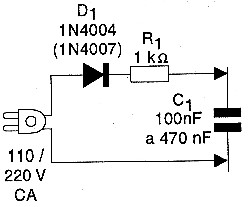The play and demonstration consist of the following: load a capacitor and throw it to the unsuspecting person, taking care to alert them with the phrase:
- hold on!
When the person holds the capacitor, in a natural reaction, the small component (apparently harmless) will occur a good electrical discharge with a "beautiful" shock applied to the visitor.
It is clear that the reader will explain everything to the visitor, showing him the principle of operation of one of the most important electronic components: the capacitor.
And then, to give another visitor another shock, it will be necessary to charge the capacitor again. Our project basically consists of a high voltage energy source whose purpose is precisely to charge the capacitor after each discharge (or shock!).
The capacitor, in order not to give a very strong shock, has low values, between 100 nF and 470 nF, giving preference to types of tubular polyester, paper or oil with working voltages of at least 220 V if the power network is 110V and at least 400V if the network is 220 V.
HOW IT WORKS
By connecting a capacitor's armatures to a DC voltage source, the capacitor charges with this voltage. The load remains as long as there is no path for the reinforcement loads. When they are connected, the charges flow and neutralize by discharging the capacitor.
By keeping the capacitor's terminal wires separate, it conserves its charge. However, when we throw the capacitor for someone to hold (being careful not to touch the terminals) when touching the two terminals (which are bent to facilitate this) at the same time, the discharge circuit is closed by the person walking through the discharge current. The result is a shock in the person's hand.
To obtain the continuous voltage that charges the capacitor, we describe the assembly of a rectifier circuit, because in the power network we have alternating voltage that is not suitable for this experiment.
ASSEMBLY
In figure 1 we have the complete diagram of the capacitor charger.

In figure 2 we have the arrangement of the components on a terminal bridge and the way to bend the capacitor terminals to make a joke or demonstration.

The diode must be 1N4004 or 1N4007 if the network is 110 V and 1N4007 if the network is 220V.
Resistor R1 is 1 k ohms or close to this value with dissipation starting at 1/8 W.
The reader must take the utmost care with the assembly and handling of this charger as it will be connected directly to the power supply, thus there is a danger of dangerous shocks to any accidental touch.
HOW TO USE
We initially observed that the shock caused by the capacitor is very fast and therefore is not dangerous. In order to have this shock, however, the two terminals must touch the person holding the component at the same time, hence the need to be bent in the manner indicated.
If the person holds a terminal, nothing happens and if the terminals touch each other when the capacitor is thrown a snap occurs and it discharges before giving a shock.
To play (or demonstrate), charge the capacitor by plugging it into the circuit output for a few seconds. When the visitor approaches distractedly, shoot the charged capacitor with a "Hold!" Alert.
To hold the component before tossing it, do not touch its terminals. The charge on ordinary capacitors tends to escape in a few minutes, in which case they must be charged again.
WHAT TO EXPLAIN
Look in the books for the working principle of capacitors or "capacitors" taking the Leyden Jar as an example.
Remind visitors that when the Leyden Bottle was discovered more than 200 years ago, its discoverers were just having fun shocking each other! (The game is therefore very old!)
Explain how a capacitor charges and how the charges are stored. Show that the storage capacity of a capacitor depends on the material used as a dielectric or insulator.
Then show how you charge the capacitor and, touching one terminal to the other, show the discharge that occurs under these conditions.
SUGGESTIONS
You can demonstrate the capacitor discharge by also connecting a neon lamp to the charged capacitor. The capacitor discharges causing the lamp to blink.
Another place where the discharge can be demonstrated is by connecting the capacitor terminals to the terminals of a speaker. The discharge is accompanied by a crackle produced by the speaker.
Note: Do not use larger capacitors to shock others as the discharge can be really strong and therefore dangerous!
D1 - 1N4004 or 1N4007 - silicon diode - see text
R1 - 1 k ohm - resistor - brown, black, red
C1 - 100 nF to 470 nF - 200 or 400V - polyester capacitor, oil or paper (see text)
Several:
Power cable, mounting box, terminal bridge, various capacitors, wires, solder, etc.



